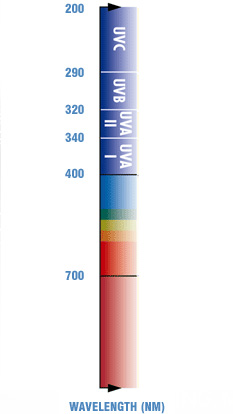







UV light spectrum
An integral part in every treatment that should not be overlooked or underestimated is the importance of photoprotection.
It is essential to implement the use of daily broad-spectrum sunscreen with a sun protection factor of 30 and sun-protective measures, such as avoidance and protective clothing.
Although clinical studies have shown that serum vitamin D levels are reduced in sunscreen users compared to nonusers, these levels are usually still within normal range.
The principal ingredients in sunscreens are usually aromatic molecules conjugated with carbonyl groups. This general structure allows the molecule to absorb high-energy ultraviolet rays and release the energy as lower-energy rays, thereby preventing the skin-damaging ultraviolet rays from reaching the skin.
So, upon exposure to UV light, most of the ingredients (with the notable exception of avobenzone) do not undergo significant chemical change, allowing these ingredients to retain the UV-absorbing potency without significant photodegradation.
A chemical stabilizer is included in some sunscreens containing avobenzone to slow its breakdown - examples include formulations containing Helioplex and AvoTriplex. The stability of avobenzone can also be improved by bemotrizinol,octocrylene and various other photostabilisers.
Sunscreen ingredients may become free radicals, themselves, when activated by UV irradiation, and sunscreen chemicals may be absorbed into skin to potentially cause harm.
>
>
>
>
>
>
>
>
>
>
>
>
>
>
>
>
>
>
TYROSINASE INHIBITORS
Polyphenols
Benzaldehyde and Benzoate Derivatives
Gallic Acid and Derivatives
Long-Chain Lipids and Steroids
INHIBITORS OF MELANOSOMAL TRANSFER
Centaureidin and Methylophiopogonanone B
Niacinamide
PAR-2 Inhibitors
Lectins and Neoglycoproteins
ANTIOXIDANTS
Glutathione
Vitamin C
Alpha Tocopherol and Alpha Tocopherol Ferulate
ACCELERATORS OF EPIDERMAL TURNOVER AND DESQUAMATORS
α-Hydroxyacids
Salicylic Acid
Linoleic Acid
Retinoids
TRANSCRIPTIONAL REGULATION OF MELANOGENIC ENZYMES
The MAPK Pathway
MC1R
cAMP Pathway and MITF

<< Previous: cAMP Pathway and MITF
Next: a-MSH BLOCKERS >>